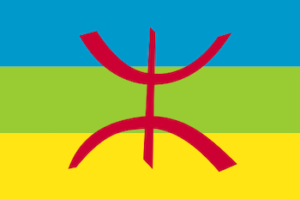
*The Berber community is celebrated on this date c 1000. Berbers are an ethnic group native to North and West Africa, specifically Morocco, Algeria, Tunisia, Libya, Mauritania, northern Mali, northern Niger, and the Canary Islands. Smaller Berber populations are also found in Burkina Faso and Egypt's Siwa Oasis.
Historically, Berber nations spoke the Berber language and were branches of the Afroasiatic family. The term Berber comes from the Greek term meaning ''barbarian'' The Romans also used the word to refer to their hostile neighbors to the north, in Germania (roughly the area that is Germany today), as well as to Celts, Iberians, Gauls, Goths, and Thracians. Among the oldest written attestations of the word, Berber is used as an ethnonym in a document from the 1st century AD Periplus of the Erythraean Sea. In ancient and medieval times, the Egyptians, Greeks, Romans, and Byzantines all used words similar to"Berbe" to refer to various tribes that inhabited"Greater Libya" (that is, what is now called North Africa), in areas where Berbers were later to be found.
Although these tribal names differ from those used in those classical sources, they are nevertheless probably related to the modern Amazigh. The Meshwesh tribe was the first of these tribes to be identified by researchers. In Latin sources, the tribe was called Mazaces and Mazax and was related to the later Massylii. Late antiquity Roman and Coptic language sources record that a tribe called Mazices conducted multiple raids against Egypt. All these names are similar to the names used by the Berbers to refer to themselves and are perhaps foreign renditions of that name: Imazighen or i-Mazigh-en (singular: a-Mazigh). Despite the evidence in these early manuscripts, certain modern scholars have debated that the term only emerged around 900 AD in the writings of Arab genealogists.
Maurice Lenoir posited that the term first appeared in the 8th or 9th century. Ramzi Rouighi debates that the use of Berber to refer to the people of North Africa appeared only after the Muslim conquests of the 7th century. Latin and Greek sources describe Moors, Africans, and even barbarians, but never Berbers (al-Barbar). The English term was introduced in the 19th century, replacing the earlier Barbary. The Berbers are the Mauri cited by the Chronicle of 754 during the Umayyad conquest of Hispania, Mauri having become, since the 11th century, the catch-all term 'Moors’ on documents of the Christian Iberian kingdoms to refer to the Andalusi, the north Africans, and the Muslims overall.
The social structure of the Berbers is tribal. A leader is appointed to command the tribe. Many women, such as Kahina and Tazoughert Fatma in the Aurès, had the power to govern in the Middle Ages. Lalla Fatma N'Soumer was a Berber woman in Kabylie who fought against the French. In the 21st century, most Berber tribes have men as heads of the tribe. In Algeria, the el Kseur platform in Kabylie gives tribes the right to fine criminal offenders. In areas of Chaoui, tribal leaders enact sanctions against criminals. The Tuareg have a king who decides the fate of the tribe. It is a very hierarchical society. The Mozabites are governed by the spiritual leaders of Ibadism and lead communal lives. During the crisis of Berriane between the Maliki and Ibadite movements, the heads of each tribe began talks to end the crisis and resolve the problem.

In marriages, the man usually selects the woman, and depending on the tribe, the family often decides. In contrast, in the Tuareg culture, the woman chooses her future husband. The rites of marriage are different for each tribe. Families are either patriarchal or matriarchal, according to the tribe. Traditionally, men take care of livestock. They migrate by following the natural grazing cycle and seeking water and shelter. They are thus assured of an abundance of wool, cotton, and plants used for dyeing. For their part, women look after the family and handicrafts, first for their personal use and secondly for sale in the souqs in their locality.
Like quilts made by Black Africans in America, Berber tribes traditionally weave kilims (tapestry-woven carpets), whose designs maintain the traditional appearance and distinctiveness of the region of origin of each tribe, which has, in effect, its repertoire of drawings. The plain weave textile designs include many stripes and, more rarely, geometrical patterns such as triangles and diamonds. Additional decorations such as sequins or fringes are typical of Berber weave in Morocco. The nomadic and semi-nomadic lifestyle of the Berbers is suitable for weaving kilims. Traditional Berber jewelry women wear is usually silver and includes fibulae (garment clasps), wide bracelets or cuffs, and elaborate earrings.
Some of the best-known ancient Berbers are the Numidian kings Masinissa and Jugurtha, the Berber-Roman author Apuleius, Saint Augustine of Hippo, and the Berber-Roman general Lucius Quietus, who was instrumental in defeating the primary wave of Jewish revolts in ancient Israel. The Berber identity encompasses language, religion, and ethnicity and is rooted in the entire history and geography of North Africa. Berbers are not entirely homogeneous, including various societies, ancestries, and lifestyles. The unifying forces for the Berber people may be their shared language or a collective identification with Berber heritage and history.